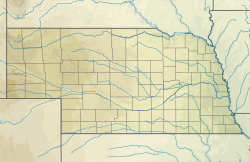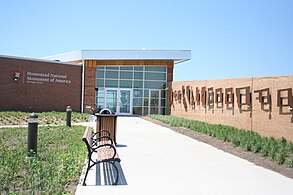Homestead National Historical Park
Homestead National Historical Park | |
Former U.S. National Monument | |
| Location | Gage County, Nebraska, United States |
|---|---|
| Nearest city | Beatrice, Nebraska |
| Coordinates | 40°17′07″N 96°49′19″W / 40.28528°N 96.82194°W |
| Area | 211 acres (85 ha)[2] |
| Visitation | 123,400 (2017)[3] |
| Website | www |
| NRHP reference No. | 66000115[1] |
| Significant dates | |
| Added to NRHP | October 15, 1966 |
| Designated NHP | January 13, 2021 |
| Designated NMON | March 19, 1936 |
Homestead National Historical Park, a unit of the National Park System known as the Homestead National Monument of America prior to 2021, commemorates passage of the Homestead Act of 1862, which allowed any qualified person to claim up to 160 acres (0.65 km2) of federally owned land in exchange for five years of residence and the cultivation and improvement of the property. The Act eventually transferred 270,000,000 acres (1,100,000 km2) from public to private ownership.
The park is five miles (8 km) west of Beatrice, Nebraska, on a site that includes some of the first acres successfully claimed under the Homestead Act. The national monument was first included in the National Register of Historic Places in 1966.[1]
Homestead Heritage Center and Education Center
[edit]The Homestead Heritage Center, dedicated in 2007, contains exhibits that treat the effect of the Homestead Act on immigration, agriculture, native tribes, the tallgrass prairie ecosystem, and federal land policy. The roof line of the center resembles a "single bottom plow moving through the sod," and the parking lot measures exactly one-acre (4,000 m2).[4] A separate Education Center features science and social science presentations that can be shared with classrooms anywhere in the United States through distance-learning.[5]
-
Heritage Center entrance
-
Heritage Center
-
Education Center
Tallgrass prairie
[edit]The park includes 100 acres (0.40 km2) of tallgrass prairie restored to approximate the ecosystem that once covered the central plains of the United States—and that was nearly plowed into extinction by the homesteaders. This restoration, which necessitates regular mowing, haying, and prescribed burns, has been managed by the National Park Service for more than 60 years and is the oldest in the National Park System.[6] The park maintains about 2.7 miles (4.3 km) of hiking trails through the prairie and the woodland surrounding Cub Creek, accessible via all-terrain wheelchair.[7]

Palmer-Epard Cabin
[edit]
In 1867, George W. Palmer built the Palmer-Epard Cabin from mixed hardwoods about 14 miles (23 km) northeast of the park. It measures 14 by 16 feet (4.3 m × 4.9 m) and is representative of the local construction style. Palmer lived in the cabin with his wife and ten children. Between 1875 and 1880, a 10-by-12-foot (3.0 m × 3.7 m) lean-to was added to the rear of the cabin, and the Palmers continued to live in it until 1895, when it was sold to nephews Eugene Mumford and William Foreman. A few years later, the farm was sold to Lawrence and Ida Mumford Epard, who lived in the cabin for nearly 40 years. The cabin was donated to the park in 1950 and has been moved and restored several times in intervening years.[8]
Freeman School
[edit]
The Freeman School, built of foot-thick red brick with carved limestone lintels, was the longest continuously used one-room school in Nebraska (1872–1967). The school also served as a Lutheran church, a polling place for Blakely Township, and a community center for debates, clubs, and box socials. The National Park Service restored the school to appear as it did during the 1870s.[9]
The Freeman School was the focus of an early, influential judicial decision regarding separation of church and state. In 1899, Daniel Freeman sued the school board after a teacher, Edith Beecher, refused to stop praying, reading the Bible, and singing gospel songs in her classroom. In Freeman v. Scheve, et al. (1902), the Nebraska Supreme Court ruled that Beecher's activities violated provisions of the Nebraska constitution.[10]
Administrative history
[edit]Daniel Freeman (1826–1908), a native of Ohio, filed the first homestead claim in the Brownville, Nebraska land office on January 1, 1863. By the mid-1880s, Freeman also claimed to have been the first homesteader in the nation.[11] Freeman eventually amassed more than 1,000 acres (4.0 km2) and became a prominent citizen of Gage County. As early as 1884, he first proposed the idea of memorializing himself as the earliest homesteader, and shortly after his death in 1908, Beatrice residents talked of preserving his homestead as a national park.[12]
Proposals to create such a park were rejected[13] until during the mid-1920s, the influential Senator George W. Norris suggested a historical museum of agricultural implements be established on the Freeman property and the local chapter of the Daughters of the American Revolution dedicated a marker there.[14]
In 1934, Beatrice citizens organized the National Homestead Park Association,[15] reinvigorating the movement. In 1935, Norris and newly elected congressman Henry C. Luckey of Lincoln introduced legislation to create the Homestead National Monument of America, which eventually became law in March 1936. But federal funding for the purchase was not obtained until March 1938. Negotiations with the Freeman heirs "dragged on for months over the value of the land," and condemnation proceedings were instigated to bring them to terms. The government took possession at the end of the year.[16]
A few improvements were made to the site before American entrance into World War II effectively ended both visitation and development. In the 1950s, the National Park Service acquired the Palmer-Epard cabin and built a visitor center as part of its Mission 66 program.[17] A small museum there exhibited some of the artifacts donated to the park by the Gage County Historical Society in 1948.[18] By 1981 the national monument had five permanent employees, one part-time employee, and some seasonal personnel.[19]
In the 1970s and '80s, seasonal rangers presented living history demonstrations, although many of their activities were later viewed as "not historically accurate for the homestead era" and "more reminiscent of the Appalachian hill country than prairie homesteads."[20] By the 1990s, the NPS had limited funding for such interpretation, and the monument began to extend the story of the Homestead Act to other regions of the country. Under Superintendent Mark Engler, a Beatrice native, the national monument dedicated the Homestead Heritage Center in 2007 with more interactive displays that treated the Homestead Act from a broader prospective, a change symbolized in part by a "Living Wall" at its entrance with a physical representation of the percentage of land successfully homesteaded in each state.[4] The monument was renamed to Homestead National Historical Park in 2021.[21][22]
References
[edit]- ^ a b "National Register Information System". National Register of Historic Places. National Park Service. November 2, 2013.
- ^ "Listing of acreage – December 31, 2011" (XLSX). Land Resource Division, National Park Service. Retrieved 2012-05-14. (National Park Service Acreage Reports)
- ^ "NPS Annual Recreation Visits Report". National Park Service. Retrieved 2012-05-14.
- ^ a b Homestead NM website.
- ^ Homestead NM website.
- ^ Homestead NM website; Rose Houk, Homestead National Monument of America (Fort Washington, PA: Eastern National, 2000), 37. Curiously, there is no legislative mandate in the enabling legislation for restoring the prairie.
- ^ Homestead NM website
- ^ Houk, 35; Robert Tecklenberg, "Homestead National Monument of America: An Administrative History, 1962-1981," 8; Homestead NM website.
- ^ Houk, 39; Homestead NM website. The school may have been named either for Daniel Freeman or Thomas Freeman (no relation), a local bricklayer who likely made the bricks for the school. Both men served on the school board contemporaneously.
- ^ Jeremy Patrick, "The Religion Provisions of the Nebraska Constitution: An Analysis and Litigation History," Journal of the Law and Religion, 19 (2004), 331 ff.
- ^ See Charles Plante and Ray H. Mattison, "The 'First' Homestead," Agricultural History, 36 (October 1962), 183-93. Freeman said that as a spy for the Union army, he had been suddenly ordered to St. Louis, and therefore convinced the land office registrar to let him file his claim just after midnight of the old year. There is no evidence to confirm Freeman's story; in fact, there is no record of Freeman ever having served in either the army or the Secret Service.
- ^ Ray H. Mattison, "Homestead National Monument: Its Establishment and Administration," Nebraska History, 43 (March 1962), 7.
- ^ At the time, national parks were effectively limited to places of "extraordinary…beauty, freaks of nature, geysers, etc." Beatrice Daily Sun, January 28, 1911, quoted in Mattison, 9.
- ^ Mattison, 9-10.
- ^ Friends of Homestead National Monument of America is a lineal descendant of this private group. See Friends of Homestead, “Our History,” website.
- ^ Mattison, 16-24.
- ^ Mattison, 26-27.
- ^ Robert Tecklenberg, "Homestead National Monument of America: An Administrative History, 1962-1981," 2.
- ^ Tecklenberg, 17.
- ^ L. S. Lange, "Homestead National Monument of America: A Half Century of Interpreting Prairie History," Journal of the West, 38 (January 1999), 31.
- ^ James, Karla (2021-02-05). "Nebraska Delegation Lauds Enactment of Bill to Rename Homestead National Monument into Law". KLIN-AM. Retrieved 2021-02-08.
- ^ "Text - H.R.1472 - 116th Congress (2019-2020): To rename the Homestead National Monument of America near Beatrice, Nebraska, as the Homestead National Historical Park". www.congress.gov. 2021-01-13. Retrieved 2021-01-15.
External links
[edit]- Official website

- The Freeman School: Building Prairie Communities, a National Park Service Teaching with Historic Places (TwHP) lesson plan
- Groundbreaking Ceremony - NET Television
- Historic American Buildings Survey (HABS) No. NE-21, "Palmer-Epard Cabin, Beatrice, Gage County, NE"
- HABS No. NE-22, "Freeman School, Beatrice, Gage County, NE"
- 1936 establishments in Nebraska
- Federal lands in Nebraska
- Historic American Buildings Survey in Nebraska
- History museums in Nebraska
- Museums in Gage County, Nebraska
- National Park Service areas in Nebraska
- National Register of Historic Places in Gage County, Nebraska
- Protected areas established in 1936
- Protected areas of Gage County, Nebraska
- National historical parks of the United States






